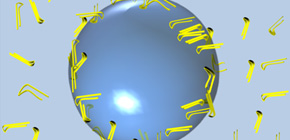
Successful 1,000-fold enhancement of reaction velocity constants for proteins’ change into toxic substances
Will apply to early diagnosis, treatment, and risks associated with ultrasonic irradiation regarding Alzheimer’s disease
A group of researchers led by NAKAJIMA Kichitaro (Student, Doctoral Program, Graduate School of Engineering Science, Osaka University), OGI Hirotsugu (Associate Professor, Graduate School of Engineering Science, Osaka University), and GOTO Yuji (Professor, Institute for Protein Research, Osaka University) succeeded in increasing the velocity constant for a reaction in which proteins causing Alzheimer disease (AD) turn into toxic substances to 1,000 times by using optimum frequency of ultrasonic irradiation.
When an ultrasonic wave is irradiated in solution with proteins, cavitation bubbles often repeatedly grow and collapse. This group found that these bubbles collect harmless proteins in solution, generating toxic substances whenever they collapse, changing into aggregates. This group also found that this phenomenon became prominent at the frequency of about 30 kHz. It is thought Amyloid-β peptides form neurotoxic aggregates in the brain, developing AD. In developing drugs, it’s important to identify and create toxic aggregates and explore drug candidates targeting them, but formation of A β aggregates often takes a very long time. Therefore, technology for accelerating the aggregation reaction in low concentrations has been greatly sought after.
Accelerating the aggregation reaction of Amyloid-β is also important in giving a diagnosis. For early detection of AD, it’s effective to evaluate the aggregation capacity of Amyloid-β. Individuals who have an internal environment in which Amyloid-β tends to aggregate have a high risk of developing AD. However, it’s difficult to aggregate Amyloid-β in the body, so technology for accelerating the aggregation reaction is required.
In recent years, it was found that ultrasonic irradiation increases the aggregation reaction of various proteins. Using their own ultrasonic irradiation device, this group explored conditions for enhancing aggregation of Amyloid-β by changing acoustic pressure and frequency in solution independently and accurately.
As a result, this group succeeded in increasing the reaction velocity constant to 1,000 times by optimizing acoustic pressure at a frequency of 30 kHz.
Furthermore, this group found out that this acceleration phenomenon was brought on by cavitation bubbles which generate and collapse along with the cycle of ultrasonic waves and succeeded in theoretically reproducing this phenomenon.
This group's achievement can be applied to techniques for early diagnosis of AD and demonstrates the conditions for reducing various risks associated with diagnosis and treatment using ultrasonic waves.

Figure 1
Abstract
Structural evolution from monomer to fibril of amyloid β peptide is related to pathogenic mechanism of Alzheimer disease, and its acceleration is a long-running problem in drug development. This study reveals that ultrasonic cavitation bubbles behave as catalysts for nucleation of the peptide: The nucleation reaction is highly dependent on frequency and pressure of acoustic wave, and we discover an optimum acoustical condition, at which the reaction-rate constant for nucleation is increased by three-orders-of magnitudes. A theoretical model is proposed for explaining highly frequency and pressure dependent nucleation reaction, where monomers are captured on the bubble surface during its growth and highly condensed by subsequent bubble collapse, so that they are transiently exposed to high temperatures. Thus, the dual effects of local condensation and local heating contribute to dramatically enhance the nucleation reaction. Our model consistently reproduces the frequency and pressure dependences, supporting its essential applicability.
To learn more about this research, please view the full research report entitled "Nucleus factory on cavitation bubble for amyloid β fibril" at this page of the Physical Review Letters website.
Related link

